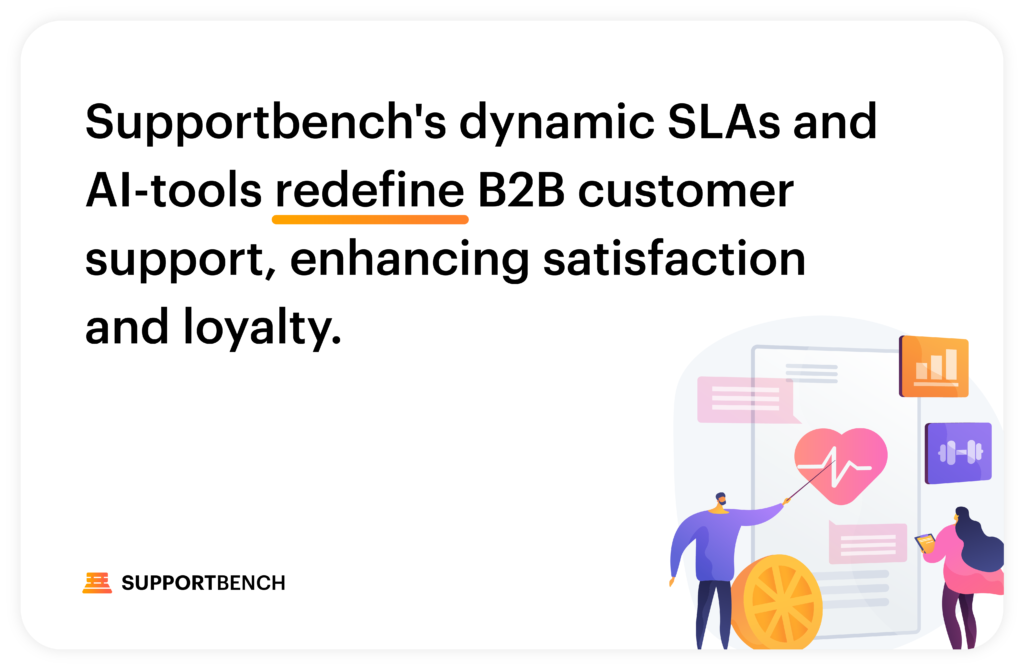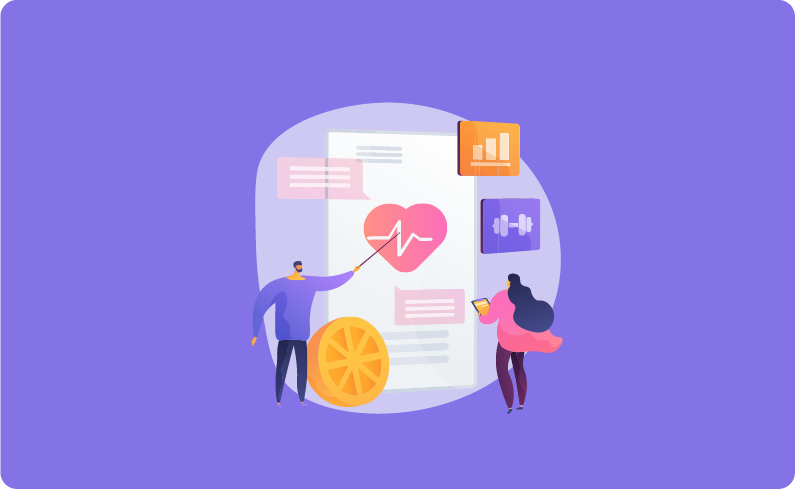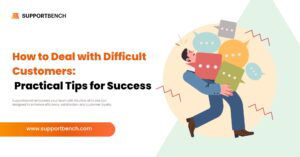In the B2B Enterprise, trust is a cornerstone that supports and elevates customer relationships. This trust is fostered through transparency and understanding, especially in customer health scoring. As a company dedicated to revolutionizing customer support, Supportbench understands this. Our tools are designed to offer clarity and insight, ensuring that both support departments and companies at large benefit significantly.

The Importance of Transparent Customer Health Scoring
Customer health scoring is not just a metric; it’s a strategic insight that shapes the trajectory of customer relationships. Transparently scoring customer health does more than just provide a numerical value – it offers a window into the customer’s experience, needs, and expectations.
There are 5 significant ways in which you can build this Customer Trust:
1. Case Studies & Statistics
A study by Gartner highlighted that companies focusing on customer health metrics saw a 24% increase in their average revenue. Another report from Forrester found that customer-centric companies were 60% more profitable compared to companies not focused on customer health. A large part of the reason for this is, companies focusing on customer health metrics often have higher customer retention rates. Retained customers tend to buy more over time and are cheaper to serve than acquiring new customers, leading to increased revenue and reduced churn. Additionally, by monitoring customer health, companies can identify opportunities for upselling and cross-selling. Satisfied customers who have a positive health score are more likely to consider additional products or services and even be more likely to refer you to others.
To take advantage of these massive benefits, here are some things you can begin right away.
- You can start by implementing a holistic scoring system. This goes beyond just tracking support interactions. You can include factors like product usage, satisfaction scores, and renewal rates. For instance, using Supportbench’s dynamic SLAs and customer health scoring, you can get a 360-degree view of each customer’s interaction with your product.
- Also, regularly updating and reviewing scores can be beneficial. You can set a standard frequency for updating customer health scores. This ensures that the data reflects current customer states, allowing for timely interventions.
- Certainly, personalize customer interactions help. You can easily use health scores to tailor conversations. So, if a customer’s score drops, a personalized check-in can go a long way. Supportbench’s AI-driven sentiment analysis can help identify these needs proactively.
2. Data-Driven Optimization and Innovation
Let’s be clearn, data as the core of almost all decision making. And if it’s not, it likely should be 😉 In this approach, every decision, strategy, and action is guided by data. This means moving away from guesswork or intuition and relying on concrete, actionable insights derived from customer health scores and other relevant metrics. And by using data-driven methods, you can anticipate customer needs, preferences, and potential issues before they escalate. With that said, data-driven optimization is an ongoing process that involves regularly analyzing performance, identifying areas for improvement, and implementing changes based on what the data reveals.
With regard to Customer Health Scores, data will give you a holistic view of all of your customer relationships. And that is because your customer health scores compile various data points – like product usage, support interaction quality, payment history, and satisfaction levels – into a comprehensive metric. This score offers a snapshot of the customer’s overall relationship with your business. So, instead of waiting for problems to arise, customer health scores enable your teams to proactively manage relationships. For instance, a declining health score might prompt a check-in call or tailored support, addressing issues before they lead to churn. There are a number of immediate ways you can take advantage of all of this.
- Integrating AI and Analytics
Tools like Supportbench can use AI to analyze customer interactions, feedback, and health scores, providing insights that help tailor customer experiences and predict future needs. You then have deep insights into your customers’ moods and trends; shaping how you approach each customer. This also helps with attending to matters before they escalate and also forecasting potential churn.
- Customized Reporting
Using the insights gained from customer health scores, support teams can customize their interactions. For instance, a customer with a high health score might receive different communication or offers compared to one with a lower score. Tools like Supportbench, with their customizable dashboards generating specific reports focusing on customer health trends and areas needing attention can be a game changer for your team and organization.
- Train Your Team on Data Interpretation
It’s great to have the data available and on hand, but you must ensure your team understands how to interpret and act on that data. So regular training sessions can be instrumental in this. Also, using more modern Support platforms like Supportbench, with it’s real-time dashboards giving you simple and accurate customer health scores, will enable you to make quick decisions and responses. This visibility is crucial for maintaining a trully data-driven approach.
3. Autonomous and Scalable Customer Support Infrastructure
An autonomous support infrastructure empowers teams to be more efficient and responsive. It largely hinges on the use of automation and artificial intelligence. These technologies handle routine inquiries and tasks, freeing up your support agents to focus on more complex issues. This not only improves efficiency but also ensures that customer support is not bottlenecked by human limitations. Also, providing your customers with the tools to find answers and resolve issues independently is another key aspect. This could include comprehensive FAQs, intelligent chatbots, or interactive knowledge bases, all of which contribute to a more autonomous customer support environment.
With that said, scalability means that as your business grows, your support infrastructure can grow with it, without a loss in service quality or an exponential increase in costs. This involves having a system that can handle an increasing number of inquiries, more complex customer needs, and integration with additional products or services. And as demand fluctuates, a scalable system can adjust resource allocation accordingly. This might mean automated scaling of server resources in a cloud-based system or adjusting staffing levels based on predictive analytics. A scalable system often relies on modular components that can be added, removed, or upgraded independently. This allows for customization according to evolving business needs and easy integration with other tools and platforms, like CRM systems or analytics software.
Supportbench’s platform is designed to scale with your business, adapting to changing needs seamlessly. Supportbench’s chatbot, powered by GPT technology, offers immediate assistance, reducing wait times and improving overall customer satisfaction. Using a more modern Support system like this, here are some things you can do immediately to help your Support department:
- You can begin by integrating all of your platforms. This synchronization will give you a unified view of the customer and ensure that all customer-related data is in one place, enhancing efficiency.
- Empowering your team with the right tools is a game changer. Tools like Supportbench’s email editor and customizable dashboards ensure that your team has what they need to be effective and efficient.
4. The Revolutionary Aspect of Supportbench
Supportbench stands out in its approach to customer support, emphasizing transparency, innovation, and autonomy. By integrating the latest AI technologies and offering a comprehensive suite of tools, it ensures that support teams are not just solving problems but are also building lasting relationships with customers.
Why Supportbench is Significant for Your Company
- Enhanced Customer Relationships: By offering a transparent view of customer health, Supportbench helps in building trust and understanding between your business and your customers.
- Data-Driven Decisions: The wealth of data available through Supportbench allows for informed decisions that align with customer needs and business goals.
- Efficiency and Autonomy: The platform’s design ensures that your support team can operate independently, reducing the dependency on IT and other departments.
Actionable Steps to Leverage Supportbench
- Deep Dive into Analytics: You can us Supportbench’s analytics to understand customer behavior and trends. This will guide your team in making informed decisions and creating personalized customer experiences.
- Automate Where Possible: Use Supportbench’s AI-driven tools to automate routine tasks. This not only increases efficiency but also allows your team to focus on more complex issues.
- Regular Feedback Loops: Implement feedback mechanisms to continuously improve your service. Supportbench’s support surveys, including NPS and CES, can provide valuable insights.
5. Step into The Future of Customer Support
In the ever-evolving landscape of customer support, staying ahead means adapting quickly to new technologies and methodologies. Supportbench’s commitment to innovation ensures that your customer support operations are always at the forefront.
Embracing New Trends
- AI and Machine Learning: Continue to explore AI-driven features for enhanced customer interaction and predictive analytics.
- Omnichannel Support: Expand your reach by integrating various communication channels, providing a seamless customer experience.
- Personalization at Scale: Use data to deliver personalized experiences to a large customer base, a key differentiator in today’s market.
Actionable Items for Embracing Future Trends:
- Invest in Training: Regular training on emerging technologies and customer support trends will keep your team knowledgeable and prepared.
- Experiment with New Features: Use Supportbench’s customizable nature to experiment with new features and integrations that can enhance customer experience.
- Gather and Act on Customer Feedback: Continuously collect and analyze customer feedback to guide your future strategies.
Conclusion
In a world where customer expectations are constantly evolving, Supportbench offers a dynamic and comprehensive solution for B2B enterprises. By focusing on seamless customer support management, data-driven optimization, and an autonomous support infrastructure, Supportbench not only addresses current needs but also paves the way for future innovations. It’s not just about providing support; it’s about building lasting relationships based on trust and understanding, making your customer support team the heroes of your organization.
As we step forward, embracing these trends and methodologies will not only enhance customer satisfaction but also propel your business towards sustainable growth and success.












